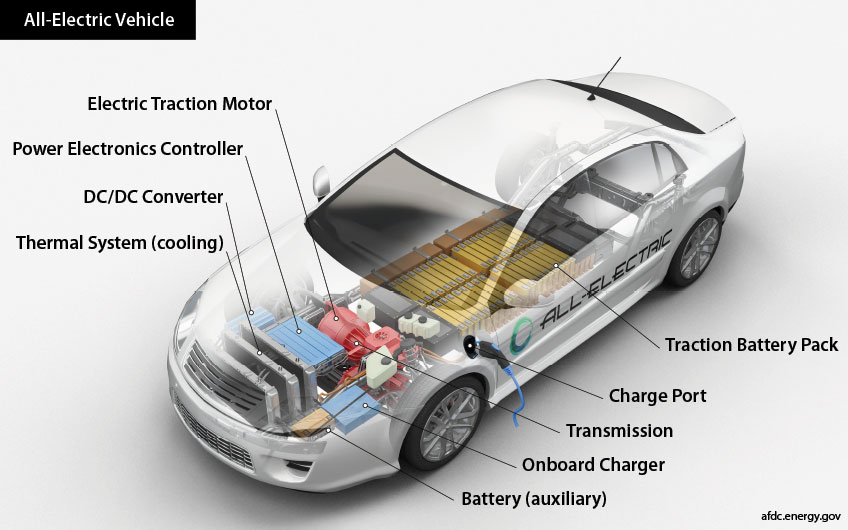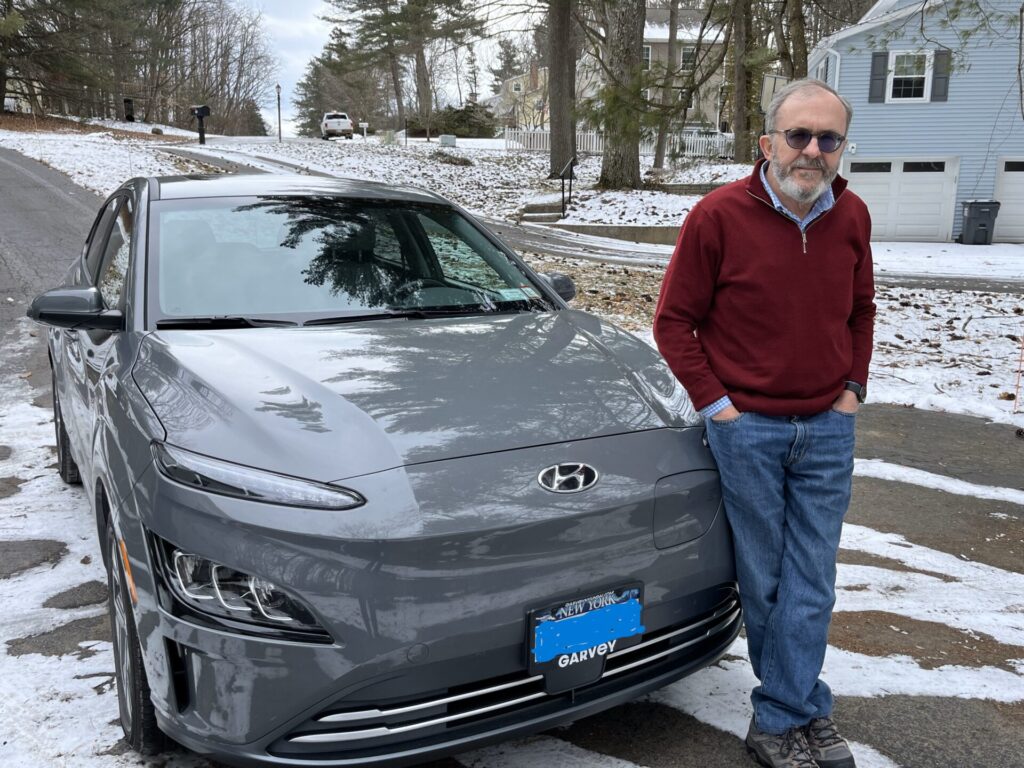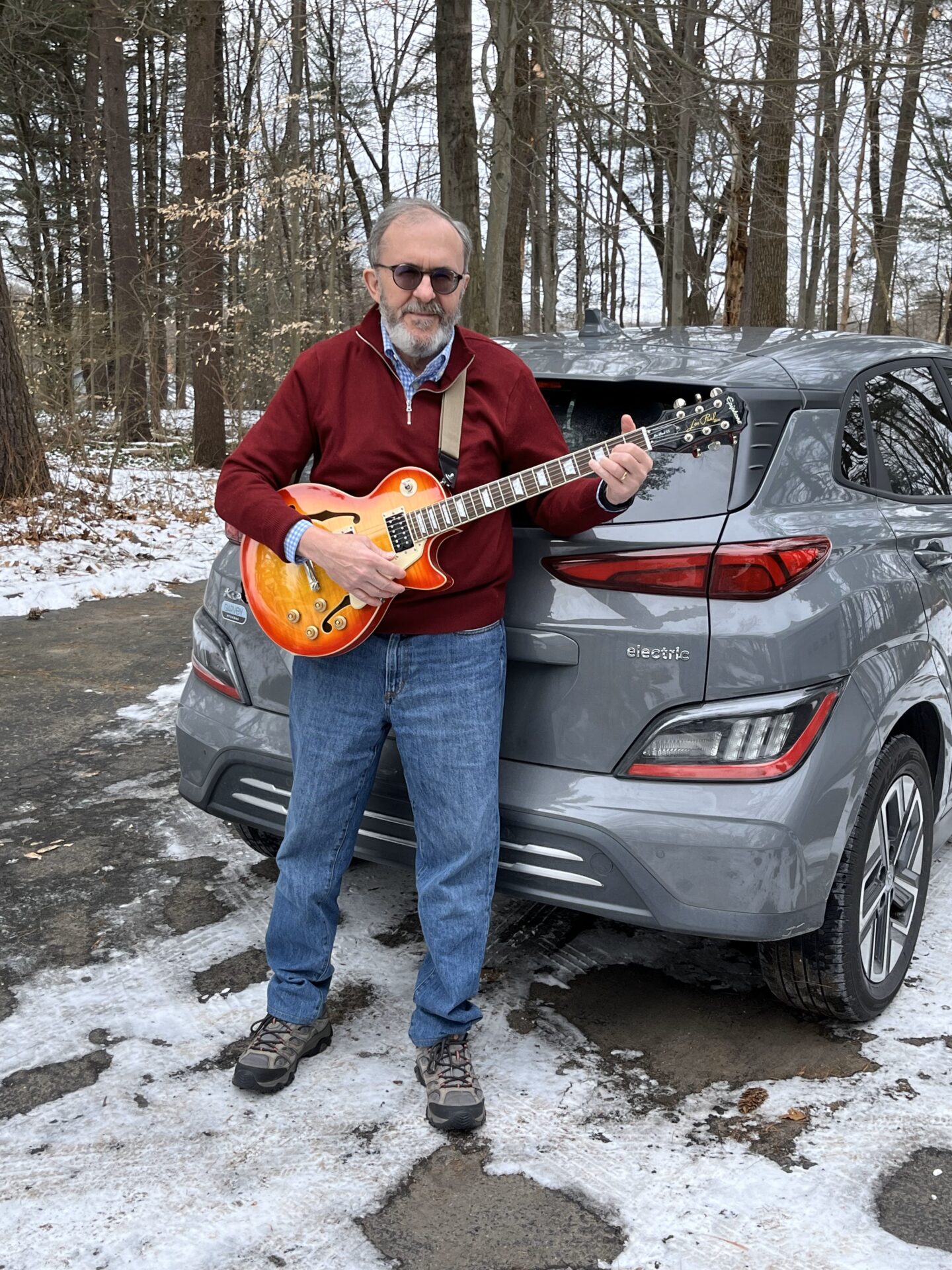Bob Dylan famously went electric, so we decided to try it too. So off we went last year to shirk off the yoke of an internal combustion, fossil-fuel-burning, pollution-emitting car. We joined the legions of drivers who chose a new electric vehicle, or EV.
It wasn’t a huge leap for our family, since I was among the first New Yorkers to buy a hybrid Toyota Prius in 2000. We drove it for years, reveling in over 50 mpg and answering questions from curious strangers who waited in parking lots to talk with us. It was a grand, successful experiment until four years later when another driver cruised through a stop sign in Saratoga Springs and totaled the Prius. But we never lost sight of our goal of burning less or no gasoline.
In 2021 we test drove and ordered an all-electric Volkswagen ID-4. We put down $500 and waited for the car to be built in Germany. We waited. And then we waited some more. The car never came in. After a year the company couldn’t assure us it would ever happen. I asked for our money back, and we resumed our search in mid-2022. The only problem was EVs were hard to find then. Unlike that first Prius, which I ordered online sight unseen, we wanted to test drive the car before buying. Salvation arrived in the form of a thorough internet search by my wife. She found available Hyundai Kona EVs at Garvey Hyundai in Queensbury, N.Y. Kona EVs are classified as small SUVs, and they earn above-average to good reliability ratings. And Hyundai offers a 10-year guarantee on the car and batteries.
The test drive and buyer experience went well. We loved the car. I felt it was a little tight. I’m not NBA-player tall but I could use an inch or two more of legroom. Even more so in the back seats. But that was a small issue. The overall vehicle performance was terrific, and we loved the leather seats and electronic safety features. We inked the deal in early December of 2022, opting for the first time to lease a car for three years and possibly buy it at the end of the deal. It was our one hedge against something going wrong with a new car that used new power technology.
Looking back over one year later, what has our experience been like? I’ve listed a few items below, but the overall answer is good to great. We haven’t had any problems. Most of all, as citizens concerned about the growing evidence of environmental damage wrought by human-caused climate change, we feel good about motoring around on electrons instead of fuel generated by dead dinosaurs millions of years ago.
Some lessons learned:
Heating and cooling sap your battery and estimated range. In an internal combustion engine car, you have a fierce source of heat sitting in front of you, channeling excess heat into your cabin. For summer air conditioning this same engine powers a compressor to feed cold air. Not so in an EV. Instead, the car passes air over a heating element to send warm air to heat those chilly toes in January (think space heater). Turning the AC compressor on takes a little less energy than heating, but the upshot is a shorter driving range. For example, when you turn an EV on you can see an “estimated” range on the dashboard, based on the current battery level. When you turn on the heat, you will instantly see the range go down between 20 to 30 miles. That’s understandable, but no one was up front with us on that issue.

Range anxiety. This is a very real issue and will remain so until charging stations become as ubiquitous as gas stations. Some scientists and engineers use the term “disruptive technology” to help people understand how they need to adapt to new technologies, such as video streaming. Our EV is great for scooting around Clifton Park, N.Y. and the Capital Region. If we leave the area for trips of 200 miles or more, though, we need to plan. Can the charging we do at home get us there and back? Are there chargers where we’re going? And can we really trust the estimated range our car gives us? Going to Cape Cod last summer we planned poorly. Driving out and coming back we had to pull off the highway each time to find a charger, which was easy since the Kona has a database that helps you find chargers.
Different charging processes. There’s Level 3, Level 2, and Level 1. Stay with me. We had to learn this on the fly, but I’m going to save you some time. Level 3 chargers are the best because they can charge your car in about an hour. Based on DC (direct current) technology, you can plug your car in, browse your phone, and get back to driving … quickly. The most common chargers (and the ones many EV owners install in their homes) are Level 2. These systems use a 240-volt AC (alternating current) circuit, like a dryer outlet in your home. But they’re slower. It takes at least six hours to charge an EV with these systems. Most EV owners are like me. They plug the car in to charge it overnight. We average about once per week. And then there’s pokey Level 1. These charger cords come with most EVs, and they use a regular 110-volt circuit in your house—but they can take upwards of three days to charge your electron-hungry vehicle. We did that for a few weeks until our licensed electrical contractor installed the Level 2 charger in our garage. Level 1 is good when you don’t have any other options, but it’s not recommended if you drive a lot.
The charging networks. Most of us have seen these pedestals scattered around the landscape at shopping malls, grocery stores, businesses, apartment complexes, and other locations. The NYS Thruway even has some at rest stops (but check ahead). What no one really explained to us is you need to find a way to pay for this charging and interact with different companies. It’s not at all expensive and it’s cheaper than gasoline. There are all sorts of online discussions about EV vs. traditional car fueling costs. A comprehensive Washington Post study last August concluded EVs were cheaper to “fuel,” but by how much depend on electricity rates in your area and the current price of gasoline. Also, right now EVs cost more to buy than traditional cars (not counting some state and federal incentives) so there is a payoff period when your lower charging rates will effectively surpass the higher car price. Back to setting up charging: What it takes is to find the companies who provide outdoor EV chargers near you and/or where you’re traveling. You then need to download a smartphone app for that system and link one of your credit cards to the app. After that, all you need to do is pull up to one of the chargers (if no one else is there; sometimes there can be a little “competition”) and, usually, you can hold up your smartphone near the card reader on the charger pedestal. It will recognize you and you can plug the cable into your car. I currently use one of the biggest nationwide charging companies, ChargePoint, and Hyundai gave us three years of free charging on ElectrifyAmerica, although they don’t have a lot of chargers around here. As a safeguard I have apps for two other public charging systems on my smartphone.
Cold affects battery life. There’s been a lot of publicity on this topic lately, especially during the recent cold snaps. Battery charging and use is based on a chemical process. Cold temps slow chemical processes. Expect your battery to provide you with shorter ranges during the winter. We found this out recently driving back here from an event in Chicopee, Mass. We found a Level 3 charger to boost our battery a bit before we left, but the cold and that long Mass Turnpike uphill slope after Westfield sapped our car’s power. We nervously watched the range indicator as it left three digits for just two in New York State. We arrived home with only 15 miles showing. We’ll do a much better job factoring in the topography and temps next time.
Other issues. Sadly, like the inarguable facts about climate change, buying and using EVs has become a political football in some quarters. That seems to be the norm with anything these days. My advice is to simply “charge” ahead and don’t listen to angry people or commenters who claim caring about energy conservation and our planet means you’ve gone “woke.” I haven’t witnessed too much of that personally, but I’ve read plenty of opinion pieces and social media discussions that criticize the EV movement. Since these criticisms are founded on the claim that climate change is a conspiracy, I don’t engage. If reasonable people ask me why I made the move, I’m happy to explain, as I’m doing now. I’m also not alone. Sales of new EVs made up 7.6 percent of new car sales in the U.S. last year, up from 5.5 percent a year earlier. I’ve also read a lot about how we’re placing an unreasonable demand on our over-burdened electrical power networks, causing more pollution in the process. I’ll let the knowledgeable and friendly folks at National Grid and elsewhere answer that concern, but my feeling is the energy is being generated anyway. We’re simply finding another way to use it. And as the smart people in this country have proven repeatedly, we’ll adapt. I’m also comforted by the fact that more of our electrical power is generated from “green” sources these days, such as wind and solar systems. One final cost issue: EVs require less maintenance than regular cars, such as oil changes, spark plugs, tuning, etc. That leads to more savings over time.


There are far too many more factors and issues to include here. And perhaps after three years of driving our Kona, I’ll have a different opinion or can expand on what I’ve mentioned here. It’s important to note we retained an older, all-wheel drive Toyota Venza to get up and down our steep driveway when there’s snow and ice on it. We don’t use the 2009 Venza much and envision a day when we’ll have an EV solution for slippery conditions.
At the end of the day our decision to go electric met a simple goal: We’re weaning ourselves off fossil fuels and emitting far less carbon dioxide and other greenhouse gases. We’re also paying less to maintain and drive the car we use almost 90 percent of the time. And we’re driving a very nice, safe car.




